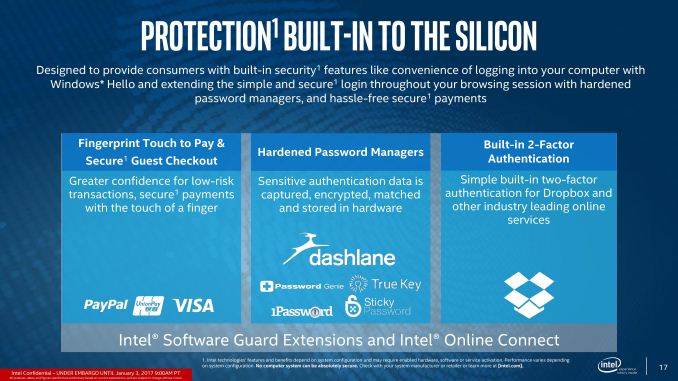Intel Launches 7th Generation Kaby Lake: 15W/28W with Iris, 35-91W Desktop and Mobile Xeon
by Ian Cutress on January 3, 2017 12:01 PM ESTIntel vPro Parts with Intel Authenticate
With the vPro variants of Kaby Lake, Intel is announcing the launch of Intel Authenticate. This is a hardware driven protection system designed to offer more security for user authentication, such as hardware based biosensors (iris, fingerprint) or location based (Bluetooth) security. Similar to how other hardware authentication based systems work, the vPro CPUs will have Intel’s Security and Software Guard Extensions (SGX) enabled to be able to isolate various instruction workflows and also detect when potential intrusion occurs. Intel did not go into any significant detail here, probably based on the initial audience for the Kaby Lake launch being more consumer oriented, but we were told that Intel is working with popular password managers to offer a more secure environment.
The vPro capable processors available from today are the i7-5Y75, i7-5Y57, i7-7600U, i7-7300U, i7-6660U, i5-7350U, E3-1535M v6, E3-1505M v6, i7-7920HQ, i7-7820HQ, i5-7440HQ, i7-7700, i5-7600, i5-7500, i7-7700T, i5-7600T and i5-7500T. These processors need to use the Q270 chipset in order to have vPro capabilities.
OPI 2.0 to OPI 3.0
From the Kaby Lake-Y/U Launch
For anyone following our NUC testing, you may remember that during testing of a Skylake-Y NUC, we found that the PCIe 3.0 x4 slot for M.2 drives was actually limited to PCIe 2.0 x4, effectively reducing the peak bandwidth. At the time we probed Intel and our data sheets to find out that it was actually a limitation imposed by Intel on the CPU which wasn’t obvious from the original launch materials. The interconnect between the CPU cores/system agent and the integrated chipset, what we normally call DMI on a desktop platform but is called OPI on an SoC, was fixed at PCIe 2.0 speeds.
We asked about why this was the case, and we were told that the system actually can support PCIe 3.0 x4 speeds, and the system even tests this on startup, but for stability PCIe 2.0 is chosen. This made the marketing of the NUC a little confusing, especially as PCIe 3.0 x4 for storage was listed as a feature. Working with Intel, they pushed through a new BIOS for the NUC that kept the OPI at PCIe 3.0 x4 speeds, and we were able to get peak bandwidth from our storage devices. However, that BIOS update was limited to one mini-PC from one vendor, leaving all the other vendors to do their own thing.
This time around, Intel is doing the change by default (on every KBL processor, except the Core i3-7100U). The interconnect to the chipset now runs at PCIe 3.0 x4 speeds, allowing the integrated chipset to offer full PCIe 3.0 lanes for extra controllers, storage and other features. For the Y series, this means 10 PCIe 3.0 lanes and the U series get 12 lanes. We could end up seeing some Core i5/i7 devices offer dual M.2 PCIe 3.0 x4 RAID as a result, depending on compatibility. Intel also lists NVMe support for the five processors on OPI 3.0.











43 Comments
View All Comments
Rampart - Friday, January 6, 2017 - link
I would say that silicon is hitting its physical limit as we can see with the yields. But that doesn't mean that we won't see some different exotic compounds taking its place.Nagorak - Thursday, January 5, 2017 - link
Based on my 2500K I'd say you're going to get at least 5 years of use out of these boards! I'd say that's pretty good for longevity!Oh, wait, that's not what you were asking?
tomi1 - Tuesday, January 3, 2017 - link
Any idea why 7820HK, 7280HQ and 7700HQ are the same msrp $340?Who in the right mind will choose 7700HQ when the HK is clearly better at the same prices.
MrSpadge - Tuesday, January 3, 2017 - link
The mobile prices don't make much sense, as in the previous generations. If there were no further discounts for the slower models, OEMs wouldn't use them at all.slideruler - Tuesday, January 3, 2017 - link
That thing Intel does is becoming a problem. As usual, the trouble lies with all the software. OSes are having trouble keeping up with all those minor tweaks (both Windows and Linux.) The worst part is that at the end of the day, with all that effort of wring new power management drivers, there is not much to show for it...MrSpadge - Tuesday, January 3, 2017 - link
Are you talking about Speed Shift v2? If so: did you miss the part about it requiring no new drivers? If not: I have no idea what you're complaining about. Is it that Linux and OSX don't have Speed Shift drivers yet? In that case Intel should never introduce any new features...yannigr2 - Tuesday, January 3, 2017 - link
The i3 7350K looks like a trolling joke. $157 for 4.2GHz? And how high can it go? 4.8GHz? Wow! 14% improvement. What would have been nice, would have been an unlocked 7100 at $110.Shadowmaster625 - Tuesday, January 3, 2017 - link
I'm hoping somebody delids one and pushes it to 5.5GHz.zepi - Tuesday, January 3, 2017 - link
Display resolution support is a disgrace. Year 2017 and they are stil stuck with dp1.2. World needs to move on. Should have moved on already long time ago so that we could actually use the high-dpi displays in bigger then 24" sizes.jjj - Tuesday, January 3, 2017 - link
So now the question is how how low does AMD go with quad Zen.From a cost perspective they can go to 49$ and up -they need to address the budget market and a quad CPU or a dual core APU are about the same area.
From a business perspective it would be better for quad Zen to start at 99$ and they would still make a killing.